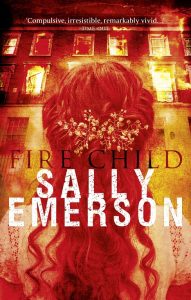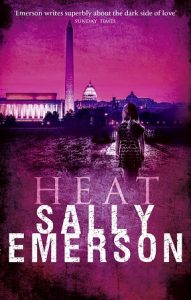Houses As Inspiration
We talk about how our relationships have changed us but comparatively little about how a love affair with a house can alter the course of our thinking and our lives. Where we live is our second skin, for women often part of our identity, so perhaps it’s no wonder that all my novels have been summoned up from the atmosphere of places I have known or lived in.
The central image that haunts me is always a house, rather than a person, and each novel is a struggle to understand that image. In ‘The Girl on the Train’ by Paula Hawkins, the image is the back of a house seen from the railway. That’s what you see in your mind as soon as you think about the book. Everything else, all the characters, all the drama, rises up out of that. It’s the same in the ‘The Great Gatsby’.
It is oddness that inspires me and so many writers, not beauty.
 In my novel ‘Fire Child’ the setting is a bedraggled old boarding house I once visited in Baalbec Road overlooking Highbury Fields in London. It was for sale and about to be gentrified like the rest of the area, but in the meantime the plump landlady wore an apron and each of the lodgers lived in a single room.
In my novel ‘Fire Child’ the setting is a bedraggled old boarding house I once visited in Baalbec Road overlooking Highbury Fields in London. It was for sale and about to be gentrified like the rest of the area, but in the meantime the plump landlady wore an apron and each of the lodgers lived in a single room.
I was inspired by the burly Victorian brick houses of Baalbec Road, with its messy truncated gardens, not the grand Georgian houses of Highbury Terrace. On returning to Highbury recently I found the juxtaposition of the burly Victorian red brick houses and the green spaces behind them perplexing and unsettling in the way that provoked me to write the story.
It was there that a young man with red hair stood at the window. He became Martin, the anti-hero whose diaries alternate with the diaries of Tessa, the girl whose smile can make any man fall in love with her. Although I invented the other characters living in the house, it didn’t feel like that. I felt I had discovered them there.
When the novel begins Tessa and Martin are both lonely, hiding from the terrible things they have already done. As a young girl Tessa’s ruthless seduction of men has caused the death of her father, while he has burnt buildings. They write diaries, and live a few streets from each other, but they don’t meet until later in the novel. When they do, their blazing love affair is going to endanger the world.
In ‘Heat’ the image that immediately comes to mind is the rambling old house I lived in from 1989 to 1992 in Washington DC. The cool white monuments of the city make Washington look so grand and formal but it’s built on a swamp.
I lived in an uneasy, strange, haunted house where huge insects beat against the window at night and racoons darted through our garden. But I loved it and the old rusty sword I found in the attic, even the phone call from the former owner who told me the house was haunted by her husband and her son who shot themselves inside its walls.
 In ‘Heat’ my heroine is in a curious state, in part because she cannot get pregnant again, and becomes obsessed by reappearance of an the old lover, who she believes is stalking her. Her sharp-eyed young daughter reports on the way her mother is beginning to fall apart. The novel is a love affair with the house and its darkness as much as it’s a love affair with the charismatic and dangerous ex-lover.
In ‘Heat’ my heroine is in a curious state, in part because she cannot get pregnant again, and becomes obsessed by reappearance of an the old lover, who she believes is stalking her. Her sharp-eyed young daughter reports on the way her mother is beginning to fall apart. The novel is a love affair with the house and its darkness as much as it’s a love affair with the charismatic and dangerous ex-lover.
My books emerge from houses that are moody and resonant. From nursery rhymes onwards – old Mrs Hubbard lived in a cupboard, the king was in his counting house – the place is where it all starts. When you look back at your past you remember where you have lived, your childhood bedroom, the pattern of the curtains, the creak of the stairs. We could all write a poem about the first house we remember.
Female writers often write stories that are about a love affair with a house as well as with a man. And of course it doesn’t have to be a happy love affair; what we like to call ‘love’ can make us miserable as well as happy. In Daphne du Maurier’s ‘Rebecca’, Manderley was based on du Maurier’s home from 1943-69, Menabilly in Fowey in Cornwall. We remember the shy nameless heroine’s humiliation and distress but it is the house representing its glorious, calculating former owner Rebecca that dominates all the characters. In ‘Gone with the Wind’ Scarlett’s love for her old plantation estate Tara is her greatest love of all.
It is not just that a writer needs a setting, it is that people are in part created out of the places they live. Sure, we might choose to live in a certain flat or house but once we have chosen that place can mould us. The atmosphere affects us, maybe of the people who have lived there before, maybe just something about the way a place is built, a worrying flimsiness or a robust and comforting quality.
My anti-heroine Tessa from ‘Fire Child’ lived as a child in the house where I lived in Wimbledon. It was a large mock-Tudor house with an unheated top floor with metal beds left behind by the previous owner. My doctor father used to chase my brother and I with his needle to give us vaccines.
We hid under those beds, where he still managed to find us and jab our bottoms. But on the whole it was peaceful, though I disliked the ignominy of being a child and being patronised and doing what I was told, including having injections I didn’t want. However, my alter ego Tessa is ruthless and does exactly what she wants, including seducing the father of her friend and next door neighbour when she is twelve.
 She is not a victim. I don’t like women and girls always being treated as victims. I like them to take control in fiction and in life. It is the neighbour’s father who has a nervous breakdown and has to leave the area, not young Tessa. She is not a sweet person but she has the power we all want.
She is not a victim. I don’t like women and girls always being treated as victims. I like them to take control in fiction and in life. It is the neighbour’s father who has a nervous breakdown and has to leave the area, not young Tessa. She is not a sweet person but she has the power we all want.
It was in the silent corners of that lovely house in Wimbledon that I used to make up stories of powerful, amoral women. Even my dolls, lined up on the window ledges, were survivors of a plane crash. They lived on a mountain and survived by stealing from the bourgeoisie in the village below. They were definitely bad, in so many ways. ‘You playing at princesses?’ my father would say as my dolls murdered and thieved and seduced.
Maybe that house created me, made me a writer, with its window ledges and privacy. I returned to the house recently and it looked exactly the same, the porch, the crazy paving drive, the laurel in the drive, the balconies on the top floor, the black beams and white pebbledash. How right I was to have loved it; unlike most lovers, it was constant and unchanged.
—
Sally Emerson is the award-winning authors of novels including Heat, Separation and Second Sight and an anthologist of poetry and prose. She lives in London. Her website iswww.sallyemerson.com.
Fire Child and Heat are published by Quartet in their Rediscovered Classics series at £10 on March 22, ‘Separation’ and ‘Second Sight’ in June, and ‘Broken Bodies’ and ‘Listeners’ in October.
Twitter: @sallyemerson8
Category: Contemporary Women Writers, On Writing






























